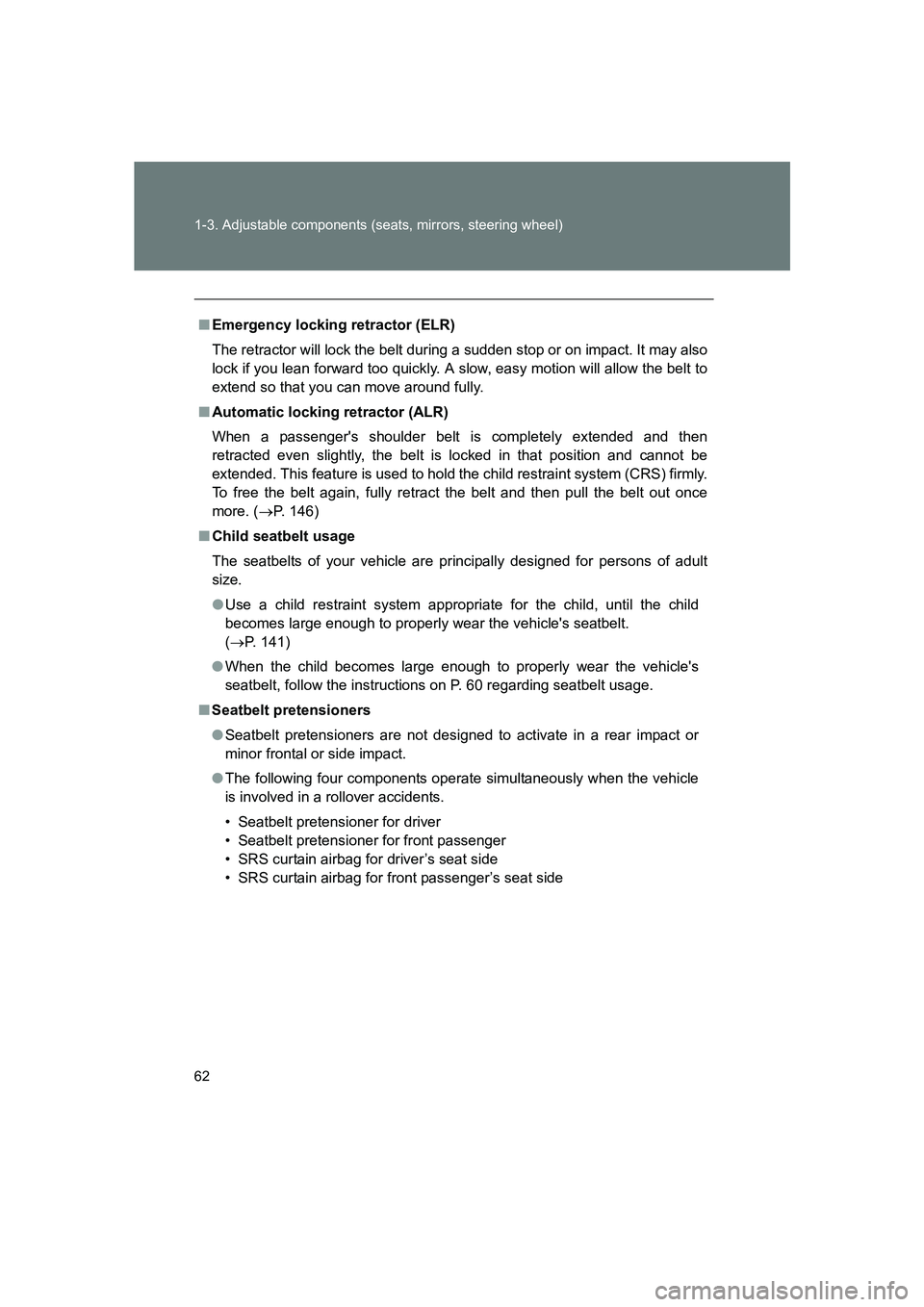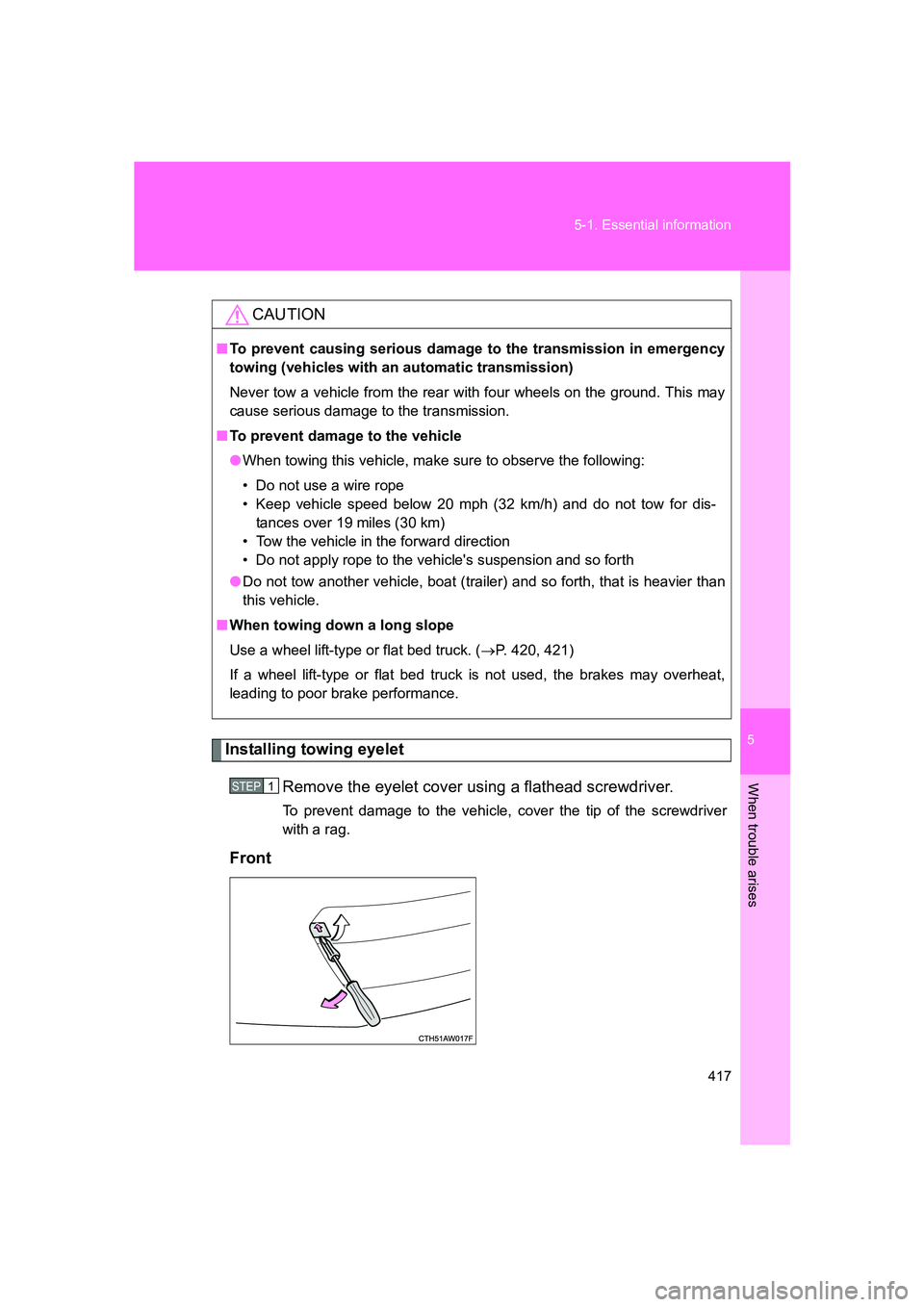Page 62 of 560

62 1-3. Adjustable components (seats, mirrors, steering wheel)
BRZ_U
■Emergency locking retractor (ELR)
The retractor will lock the belt during a sudden stop or on impact. It may also
lock if you lean forward too quickly. A slow, easy motion will allow the belt to
extend so that you can move around fully.
■ Automatic locking retractor (ALR)
When a passenger's shoulder belt is completely extended and then
retracted even slightly, the belt is locked in that position and cannot be
extended. This feature is used to hold the child restraint system (CRS) firmly.
To free the belt again, fully retract the belt and then pull the belt out once
more. ( →P. 146)
■ Child seatbelt usage
The seatbelts of your vehicle are principally designed for persons of adult
size.
●Use a child restraint system appropriate for the child, until the child
becomes large enough to properly wear the vehicle's seatbelt.
(→ P. 141)
● When the child becomes large enough to properly wear the vehicle's
seatbelt, follow the instructions on P. 60 regarding seatbelt usage.
■ Seatbelt pretensioners
●Seatbelt pretensioners are not designed to activate in a rear impact or
minor frontal or side impact.
● The following four components operate simultaneously when the vehicle
is involved in a rollover accidents.
• Seatbelt pretensioner for driver
• Seatbelt pretensioner for front passenger
• SRS curtain airbag for driver’s seat side
• SRS curtain airbag for front passenger’s seat side
Page 63 of 560

63
1-3. Adjustable components (seats, mirrors, steering wheel)
1
Before driving
BRZ_U
●
The following four components operate simultaneously when the vehicle
is subjected to a severe frontal collision.
• Seatbelt pretensioner for driver
• Seatbelt pretensioner for front passenger
• SRS front airbag for driver
• SRS front airbag for front passenger*
*: This does not operate while the occupant detection system determines to deactivate the airbag operation. For details, refer to “Front passenger’s
SRS frontal airbag” ( →P. 101)
● The following two components operate simultaneously when the vehicle
is subjected to a severe collision on the driver’s seat side of the vehicle.
• Seatbelt pretensioner for driver
• Side airbag for driver
● The following two components operate simultaneously when the vehicle
is subjected to a severe collision on the front passenger’s seat side of the
vehicle.
• Seatbelt pretensioner for front passenger
• Side airbag for front passenger
● Pretensioners are designed to function on a one-time-only basis. In the
event that a pretensioner is activated, both the driver’s and front passen-
ger’s seatbelt retractor assemblies must be replaced only by SUBARU
dealer. When replacing seatbelt retractor assemblies for the front seating
positions, use only genuine SUBARU parts equipped with a load limiter.
● If either front seatbelt does not retract or cannot be pulled out due to a
malfunction or activation of the pretensioner, contact your SUBARU
dealer as soon as possible.
● If the front seatbelt retractor assembly or surrounding area has been
damaged, contact your SUBARU dealer as soon as possible.
● When you sell your vehicle, we urge you to explain to the buyer that it
has seatbelt pretensioners by alerting the buyer to the contents of this
section.
■ Replacing the belt after the pretensioner has been activated
If the vehicle is involved in multiple collisions, the pretensioner will activate
for the first collision, but will not activate for the second or subsequent colli-
sions.
Page 417 of 560

5
When trouble arises
417
5-1. Essential information
BRZ_U
Installing towing eyelet
Remove the eyelet cover using a flathead screwdriver.
To prevent damage to the vehicle, cover the tip of the screwdriver
with a rag.
Front
CAUTION
■To prevent causing serious damage to the transmission in emergency
towing (vehicles with an automatic transmission)
Never tow a vehicle from the rear with four wheels on the ground. This may
cause serious damage to the transmission.
■ To prevent damage to the vehicle
● When towing this vehicle, make sure to observe the following:
• Do not use a wire rope
• Keep vehicle speed below 20 mph (32 km/h) and do not tow for dis-
tances over 19 miles (30 km)
• Tow the vehicle in the forward direction
• Do not apply rope to the vehicle's suspension and so forth
● Do not tow another vehicle, boat (trailer) and so forth, that is heavier than
this vehicle.
■ When towing down a long slope
Use a wheel lift-type or flat bed truck. ( →P. 420, 421)
If a wheel lift-type or flat bed truck is not used, the brakes may overheat,
leading to poor brake performance.
STEP 1